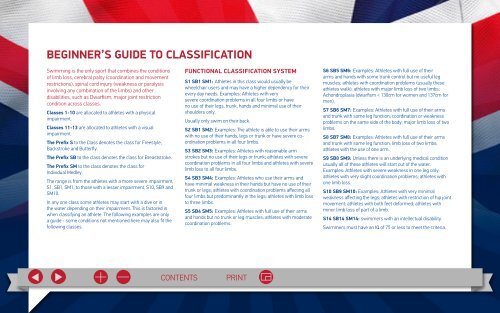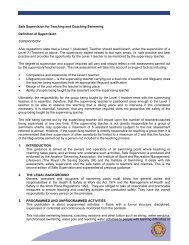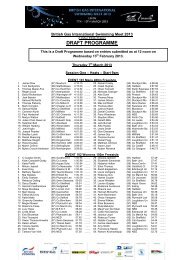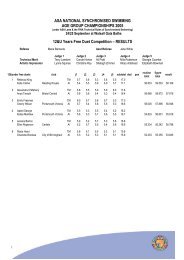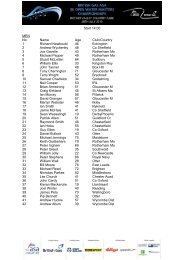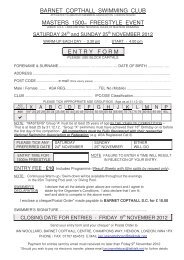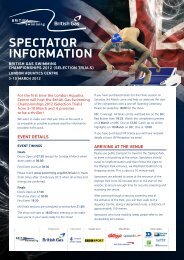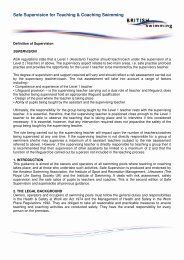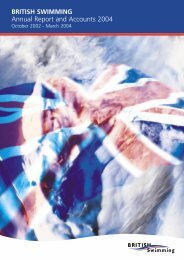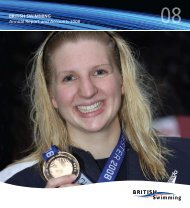IN THE POOL - Swimming.Org
IN THE POOL - Swimming.Org
IN THE POOL - Swimming.Org
You also want an ePaper? Increase the reach of your titles
YUMPU automatically turns print PDFs into web optimized ePapers that Google loves.
BEG<strong>IN</strong>NER’S GUIDE TO CLASSIFICATION<br />
<strong>Swimming</strong> is the only sport that combines the conditions<br />
of limb loss, cerebral palsy (coordination and movement<br />
restrictions), spinal cord injury (weakness or paralysis<br />
involving any combination of the limbs) and other<br />
disabilities, such as Dwarfism; major joint restriction<br />
condition across classes.<br />
Classes 1-10 are allocated to athletes with a physical<br />
impairment.<br />
Classes 11-13 are allocated to athletes with a visual<br />
impairment.<br />
The Prefix S to the Class denotes the class for Freestyle,<br />
Backstroke and Butterfly.<br />
The Prefix SB to the class denotes the class for Breaststroke.<br />
The Prefix SM to the class denotes the class for<br />
Individual Medley.<br />
The range is from the athletes with a more severe impairment,<br />
S1, SB1, SM1, to those with a lesser impairment, S10, SB9 and<br />
SM10.<br />
In any one class some athletes may start with a dive or in<br />
the water depending on their impairment. This is factored in<br />
when classifying an athlete. The following examples are only<br />
a guide - some conditions not mentioned here may also fit the<br />
following classes.<br />
FUNCTIONAL CLASSIFICATION SYSTEM<br />
S1 SB1 SM1: Athletes in this class would usually be<br />
wheelchair users and may have a higher dependency for their<br />
every day needs. Examples: Athletes with very<br />
severe coordination problems in all four limbs or have<br />
no use of their legs, trunk, hands and minimal use of their<br />
shoulders only.<br />
Usually only swim on their back.<br />
S2 SB1 SM2: Examples: The athlete is able to use their arms<br />
with no use of their hands, legs or trunk or have severe coordination<br />
problems in all four limbs.<br />
S3 SB2 SM3: Examples: Athletes with reasonable arm<br />
strokes but no use of their legs or trunk; athletes with severe<br />
coordination problems in all four limbs and athletes with severe<br />
limb loss to all four limbs.<br />
S4 SB3 SM4: Examples: Athletes who use their arms and<br />
have minimal weakness in their hands but have no use of their<br />
trunk or legs; athletes with coordination problems affecting all<br />
four limbs but predominantly in the legs; athletes with limb loss<br />
to three limbs.<br />
S5 SB4 SM5: Examples: Athletes with full use of their arms<br />
and hands but no trunk or leg muscles; athletes with moderate<br />
coordination problems.<br />
S6 SB5 SM6: Examples: Athletes with full use of their<br />
arms and hands with some trunk control but no useful leg<br />
muscles; athletes with coordination problems (usually these<br />
athletes walk); athletes with major limb loss of two limbs;<br />
Achondroplasia (dwarfism < 130cm for women and 137cm for<br />
men).<br />
S7 SB6 SM7: Examples: Athletes with full use of their arms<br />
and trunk with some leg function; coordination or weakness<br />
problems on the same side of the body; major limb loss of two<br />
limbs.<br />
S8 SB7 SM8: Examples: Athletes with full use of their arms<br />
and trunk with some leg function; limb loss of two limbs;<br />
athletes with the use of one arm.<br />
S9 SB8 SM9: Unless there is an underlying medical condition<br />
usually all of these athletes will start out of the water.<br />
Examples: Athletes with severe weakness in one leg only;<br />
athletes with very slight coordination problems; athletes with<br />
one limb loss.<br />
S10 SB9 SM10: Examples: Athletes with very minimal<br />
weakness affecting the legs; athletes with restriction of hip joint<br />
movement; athletes with both feet deformed; athletes with<br />
minor limb loss of part of a limb.<br />
S14 SB14 SM14: swimmers with an intellectual disability.<br />
Swimmers must have an IQ of 75 or less to meet the criteria.<br />
CONTENTS<br />
PR<strong>IN</strong>T


